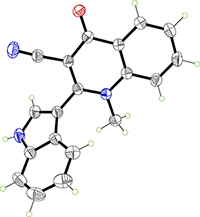/prod01/production-cdn-pxl/media/umassdartmouth/features/images/x-ray-diffractometer.jpg?text=320+Jpg)
UMass Dartmouth's newly installed x-ray diffractometer is the only one of its kind in southeastern Massachusetts.
Researchers and students at UMass Dartmouth now have access to a state-of-the-art instrument that can map the structure of a chemical compound, in three dimensions, in the matter of a day or a few hours.
The newly installed dual-source, single crystal X-ray diffractometer is the only one of its kind in southeastern Massachusetts and will advance scientists' ability to analyze the structure of a substance, an important aspect of chemistry. The new machine can map a compound in a matter of a day or even hours.
Dr. David Manke, assistant professor of chemistry and director of the new Southcoast Single Crystal X-Ray Diffraction facility, said, "Our students benefit, because they will now gain exposure to X-ray diffraction on a cutting-edge instrument, in class and in research, helping prepare them for further education or their careers."
Photo: Dr. David Manke (background right) works with Velabo Mdluli, master's candidate in chemistry, at the X-ray diffractometer. Meanwhile, undergraduate chemistry major Caitlin Bien '15 (left) and master's candidate in chemistry Alessandra Lonardo (right) review the results of earlier chemical analyses.
National Science Foundation funding benefits the region
The X-ray diffractometer was obtained through National Science Foundation (NSF) funding to support and promote the research activities of students and faculty at UMass Dartmouth, UMass Boston, Bridgewater State University, Brown University, Rhode Island College, Salve Regina University, and the University of Rhode Island.
Housed in UMass Dartmouth's Research Building, the X-ray diffractometer is available to other institutions—including area community colleges—through on-site visits and remotely via webcams and other software.
A primary tool in characterizing chemicals
Manke said that "single crystal X-ray diffraction is one of the primary tools in characterizing chemicals that have been synthesized."
 Single crystal diffraction data gives a picture of a molecule, showing the position of every atom, with the distances and angles between them—as illustrated in the image, at right, of an organic molecule synthesized in Prof. Sivappa Rasapalli's lab.
Single crystal diffraction data gives a picture of a molecule, showing the position of every atom, with the distances and angles between them—as illustrated in the image, at right, of an organic molecule synthesized in Prof. Sivappa Rasapalli's lab.
Manke added, "Single crystal X-ray diffraction couples with Nuclear Magnetic Resonance (NMR) to give a comprehensive understanding of what a chemical looks like in solution and in the solid state. UMass Dartmouth now has both technologies, having obtained an NMR spectrometer via an MRI [Major Research Instrument] grant two years ago from NSF."
Related: NMR facility represents a major step forward in research
Enhancing research in pharmaceuticals, carbon dioxide capture, green chemistry
The new device will boost research projects in pharmaceutical activity, carbon dioxide capture, small molecule activation, development of therapeutic agents for iron or H2O2 imbalance, natural product chemistry for cranberries, and green chemistry.
"Understanding the structure of a molecule helps to explain how it functions in reactions or in biological systems," Manke said. His own research focuses on the synthesis of inorganic molecules and materials.
"The primary means of characterizing these materials is X-ray diffraction," he said. "Until we had the instrument on campus, we would ship samples to San Diego for characterization, which added a great deal of time and made it difficult to get characterization for air-sensitive or unstable compounds.
"For UMassD researchers, a critical technique is now readily available and should increase the rate and quality of data produced," Manke said.
3-D images of electron density in chemical compounds
The X-ray diffractometer lets researchers determine the structure of a chemical from the scattering pattern produced when a beam of X-ray radiation interacts with the material. By measuring the angles and intensities of these patterns, a researcher can produce a three-dimensional image of the density of electrons that make up the compound.
The new instrument will allow for the single crystal structure determination of stable and air-sensitive inorganic, organic, and organometallic compounds at various temperatures. The diffractometer is a dual-source instrument, meaning it has both a copper X-ray source, especially useful for studying organic chemicals and natural products, and a molybdenum X-ray source, suitable for examining inorganic chemicals and materials with heavy metals.
More information
SouthCoast Single Crystal X-Ray Diffraction Facility
Department of Chemistry & Biochemistry